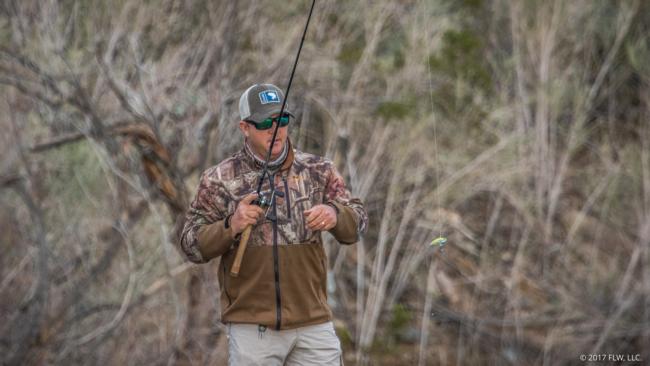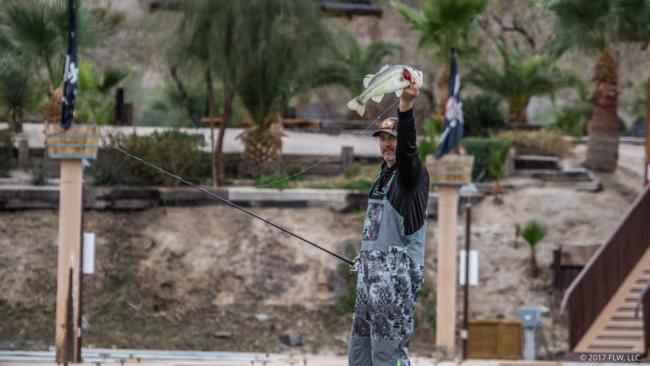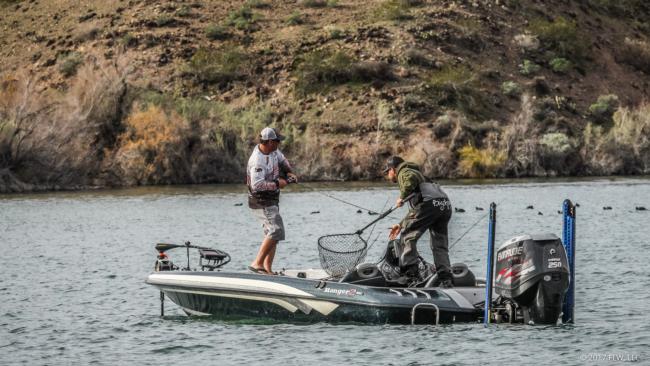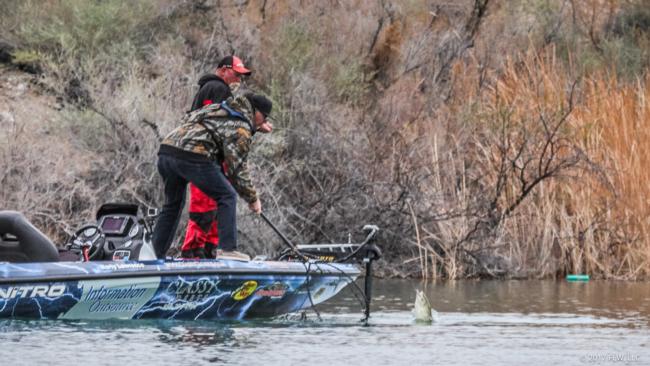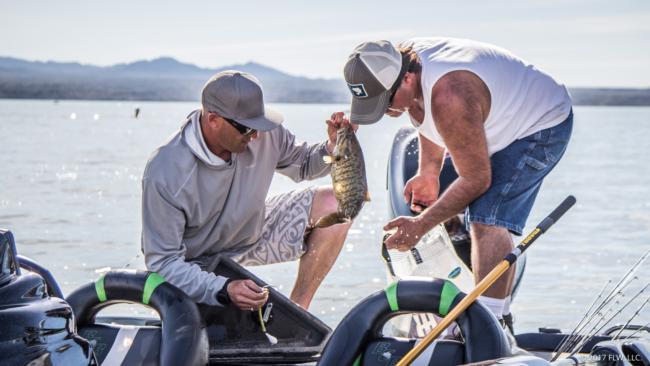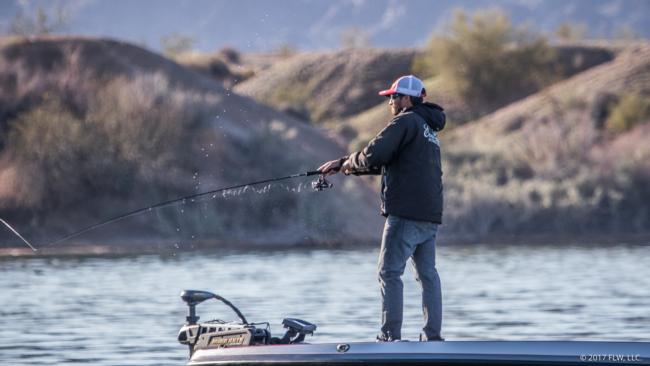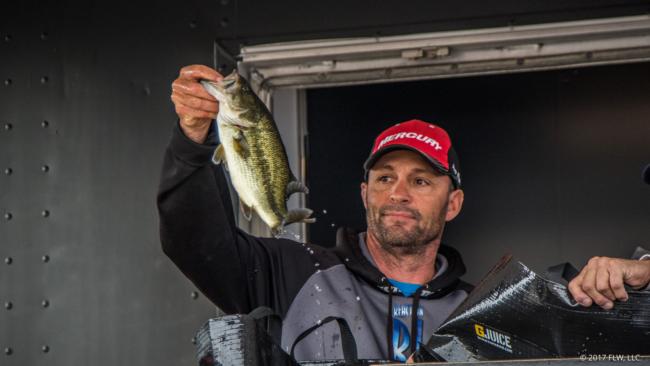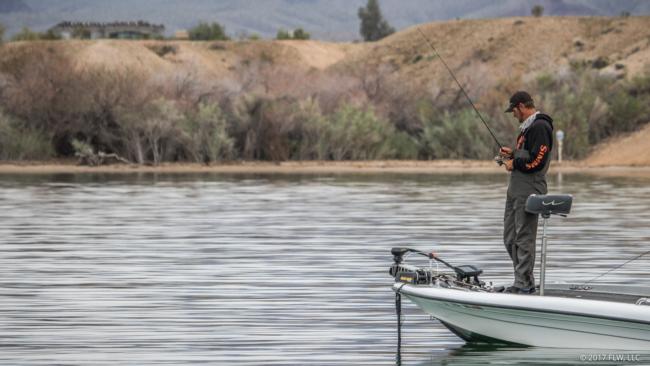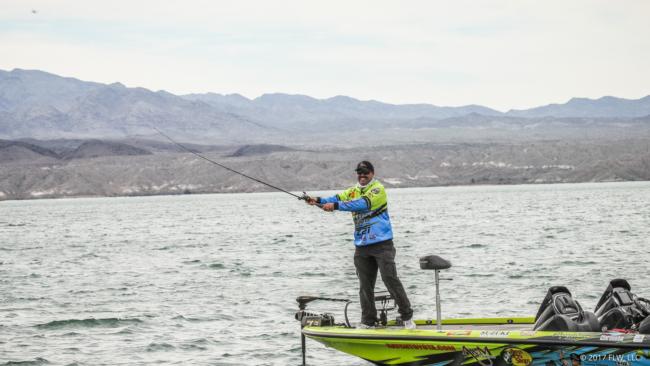Top 10 Patterns from Lake Havasu
Prespawn movement and fluctuating weather define Costa FLW Series Western Division opener
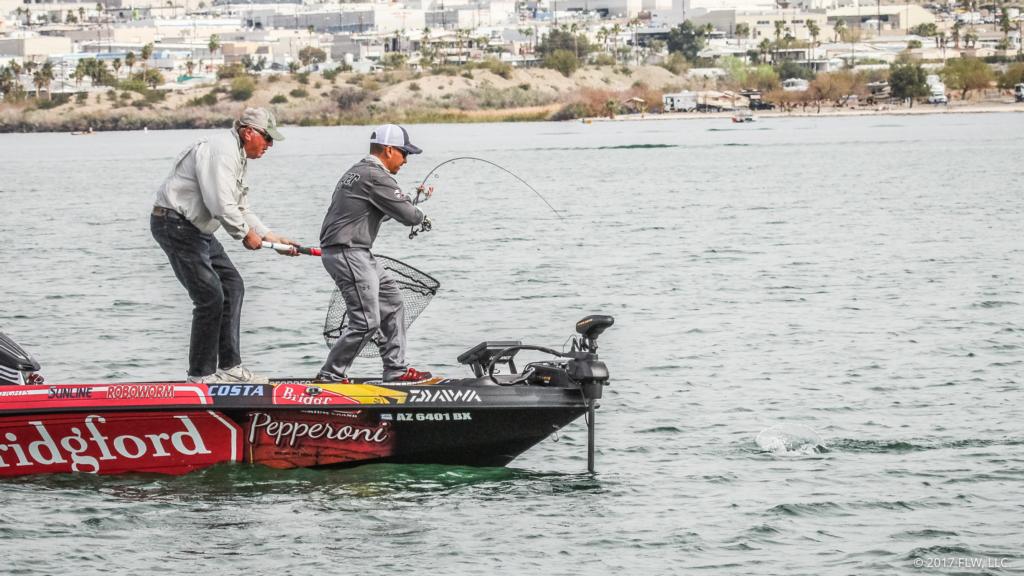
Prespawn staging greeted the Costa FLW Series Western Division opener presented by Ranger Boats on Lake Havasu, and this seasonal transition defined most of the patterns anglers pursued. Located in the Mohave Desert, this Colorado River impoundment offers a variety of shallow and near-shore features, including rocky points, gravel bars, mesquite trees, brush and tules. Also prominent are the artificial habitat structures – cages with mesh siding, sometimes enhanced with brush, palm fronts, etc. – that have been planted throughout the lake by state fisheries managers.
Weather became a significant factor during this event, as a warming trend arriving earlier in the week spurred prespawn advancement. Day one brought sunny, calm conditions, but day two saw mostly cloudy skies with 10- to 15-mph winds. In the final round, clouds covered the sky within an hour of takeoff, and the wind dropped off to barely a breeze.
Arizona pro Joe Uribe Jr. repeated his 2015 victory on Havasu with a winning total of 51 pounds, 13 ounces. Capitalizing on the prespawn advancements of hefty smallmouths, Uribe finished with a nearly 6-pound margin of victory.
2. Nichelini adjusts to place second
If you’re going to have a dip in productivity, it might be better that it falls on day two than day three. That’s what the leaderboard showed for Mike Nichelini, the Napa, Calif., pro that finished second with an even 46 pounds.
Nichelini placed second on day one with 18-9 after cranking a shade pocket with a prominent point and an artificial habitat structure. Sunny conditions made the shaded waters more attractive, but when day two brought clouds, Nichelini struggled. Weighing only 9-13, he dropped to eighth place.
Fortunately, he made the cut and was able to regroup on day three. Even though the final round lacked sun and wind, Nichelini adjusted and caught a limit that went 17-10.
“I caught them on a Lucky Craft LV 500 [lipless crankbait] the first two days, but at the end of day two they started eating an Alabama Rig with Keitech swimbaits and Strike King Rage Swimmers,” he says. “I caught my biggest day-three fish on the LV 500, but the fish were suspended, so the Alabama Rig worked the best.
“I was targeting bait chasers – prespawn fish that were staging in prespawn places. I had one honey hole that kept me going through the entire tournament, so I went back there on day three.”
3. Third-place pro Hickey runs the river
Consistently at the top of the field, Jason Hickey of Weiser, Idaho, placed fifth on day one with 16-6, rose to third a day later by catching 15-7 and added 14-1 in the final round to hold that spot with a total of 45-14. Spending all week up the Colorado River, Hickey describes his tournament as junk-fishing 101.
“I caught them on everything in the box, from crankbaits to spinnerbaits to ChatterBaits,” he says. “I only had one area because practice was kind of rough on me, so I just committed to that area.”
Hickey says the transitioning fish were frustratingly non-committal. He lacked not for bites, but had a difficult time making a solid connection.
“The fish were biting really funny,” he adds. “I think they must be getting ready to spawn. On a day when I catch 10 to 12 fish, I get 30 bites. But they just grab it and let it go. You just have to sit there and beat them on the head, beat them on the head, beat them on the head. Eventually, one would get aggressive and take it.
“It was tough on my co-anglers,” he adds. “They had plenty of opportunities, but you had to know those key angles to keep beating on them.”
4. Hawk cranks for fourth
With his home in Lake Havasu City, Roy Hawk surprised no one by making the top 10. The seasoned Western pro got off to a strong start by topping day one with a mixed bag of largemouths and smallmouths that weighed 19 pounds, 7 ounces. Hawk would give up one spot a day later when his plan of focusing on smallies yielded less than he expected – just 12-12. On day three, he kept himself in the upper half of the field by sacking up four more bronzebacks for 13-6 and finished fourth at 45-9.
Hawk’s primary game plan involved working prespawn smallmouths that were staging in progressively shallower areas. He spent the majority of his days throwing at natural features, but he also picked a few keepers off the lake’s artificial habitat.
“I caught 75 to 80 percent of my fish on a Duo Realis Vibration 68 G-Fix in ghost minnow pattern,” Hawk says. “On day three, I mostly targeted smallmouths down lake on secondary points, a little bit on primary points and little rock piles. It was a grind, but I caught some real nice ones, especially on day one. The other ones I caught were on a deep-diving crankbait, the Duo Realis G87 20A in the morning dawn color.”
5. Lack of wind hinders Lawrence
When Arizona pro Marty Lawrence rose from ninth place to first on day two, he firmly stated that the windier conditions definitely helped his bite.
In the final round, Lawrence lamented the lack of wind, and even though he nabbed a 3-pounder in the first 30 minutes, he suffered through an excruciating grind the rest of a day that yielded four keepers for 11 pounds, 12 ounces and left Lawrence in fifth with 45-2.
Lawrence threw some finesse rigs during the slowest periods of day three, but he ended up catching all of his fish on swimbaits. He experimented with a range of 2.8-, 3.8- and 4.8-inch Keitech swimbaits, with the smaller bait yielding the best results.
“I think that was because of all the pressure the lake got,” Lawrence says of the small bait’s dominance. “I was just bouncing it really slow off the bottom.
“I fished the tules and the artificial habitats. Whenever the fish would get pressured, they would go from the tules to the habitats, and where there were rocks or gravel beds, all that came together as what I was looking for.”
6. Big day two boosts Collins
After placing 16th on day one with 12 pounds, 3 ounces, California pro Gary Collins surged up the day-two standings to fifth place with 17-1. Like Lawrence, Collins found the fish eager to chase reaction baits during the windier day two. Running down the lake to the Parker Dam area and targeting banks with rocks and underwater points proved most effective.
With little wind on day three, Collins saw his numbers drop off. He posted a respectable limit of 13-3 but slipped a notch to finish sixth with 42-7.
Collins caught his fish on a Megabass Vision 110+1 in pearl white and a 1/8-ounce SPRO Phat Fly hair jig in bluegill. He committed his week to fishing for prespawn bass along rock bluffs down near the Parker Dam.
“They were just moving up. They have beds going down there, and they were just outside the beds, ready to come up,” Collins says. “If the wind was blowing, I left that rip bait in my hand. I was working it really slow. It was just a little ‘twitch-twitch-twitch,’ and they were choking it.
“If I got into any coves where the water was shallow, I’d pick up that hair jig. It was just little hops on the bottom.”
7. Atypical presentation raises Kerr to seventh
The cloudy and occasionally drizzly conditions of day three actually helped Justin Kerr by negating light penetration and making the typically apprehensive largemouths more aggressive. Adding a solid limit of 14 pounds, 2 ounces to his 13-10 and 14-9 of the first two days yielded a seventh-place total of 42-5.
The California pro caught his fish on a shad-colored Evergreen Jack Hammer bladed swim jig with a chartreuse Reaction Innovations Skinny Dipper trailer. Kerr threw this bait around brush piles and tules and found that an atypical presentation triggered most of his strikes.
“It seemed that [on day three] they were biting it on the fall,” he says. “I’d just fire it out there, let it hit the bottom and if they didn’t have it I’d wind it back in.”
Kerr surmises that the cloudy skies of day three had the largemouths in a feisty mood, which accounts for their aggressive bites on the falling lure.
8. Lee grinds it out for eighth
A perennial threat in Western competition, Robert Lee got off to a great start with a third-place limit of 17 pounds, 9 ounces, but then struggled to continue his momentum. He slipped to ninth on day two after catching 10-13 and ended up one notch higher at eighth when he added 13-13 in the final round for a 42-3 total.
The difference was direct sunlight – plenty of it on day one, very little on day two and almost none on day three. Lee found his early success by flipping plastics into what he termed “extreme shade pockets” in the tules and weed mats. During the cloudy conditions that followed, the fish loosened their positioning, and Lee shifted to sparser tules.
“I was just covering water and making multiple casts into stuff that looked good,” he says. “For the shade pockets and under the mats, I used a Beaver with a punch skirt and a 3/4-ounce weight. When it got cloudy, I switched to a Zoom Brush Hog with a 3/16-ounce weight or a small Reaction Innovations Pocket Rocket.”
9. Williams relies on swim jig and crankbaits for ninth
Posting the best comeback of the tournament, Mark Williams bounced back from a 27th-place catch of 9 pounds, 9 ounces on day one to weigh 19 pounds on day two and reach the top 10 in the No. 7 spot. He added 12-12 on day three to finish ninth at 41-5.
Williams caught his fish on a 1/2-ounce Revenge Swim Jig with a 3.8-inch Keitech Swing Impact Fat trailer and a mix of shallow-diving Lucky Craft and Strike King crankbaits.
“I was throwing the jig first thing in the morning. That’s when I was getting the majority of my bites,” Williams says. “I was throwing at brush piles and the artificial habitat boxes. On days two and three, most of my bites came on the jig. Both days, my biggest fish came in the first 10 minutes.”
10. Dim day limits Johnson to 10th
Arizona pro Johnny Johnson experienced a good start with 15 pounds on day one and 13-12 on day two. The host of the “Fishing with Johnny Johnson” TV show spent most of his time slow-rolling a white Persuader spinnerbait with double willow-leaf blades over artificial habitat boxes in about 28 feet of water.
The spinnerbait, he says, would bounce across the boxes and the brush features with less risk of snagging than baits with treble hooks. This strategy worked best during the sunny and partly sunny conditions of days one and two, but the dreary skies of day three essentially killed this bite.
When the reaction bite fizzled, Johnson shifted gears and coaxed four bites on a drop-shot Aaron’s magic Roboworm with a 1/4-ounce weight or a weightless Yamamoto Senko. He added 9-1 on day three to conclude with a 10th-place total of 37-13.
